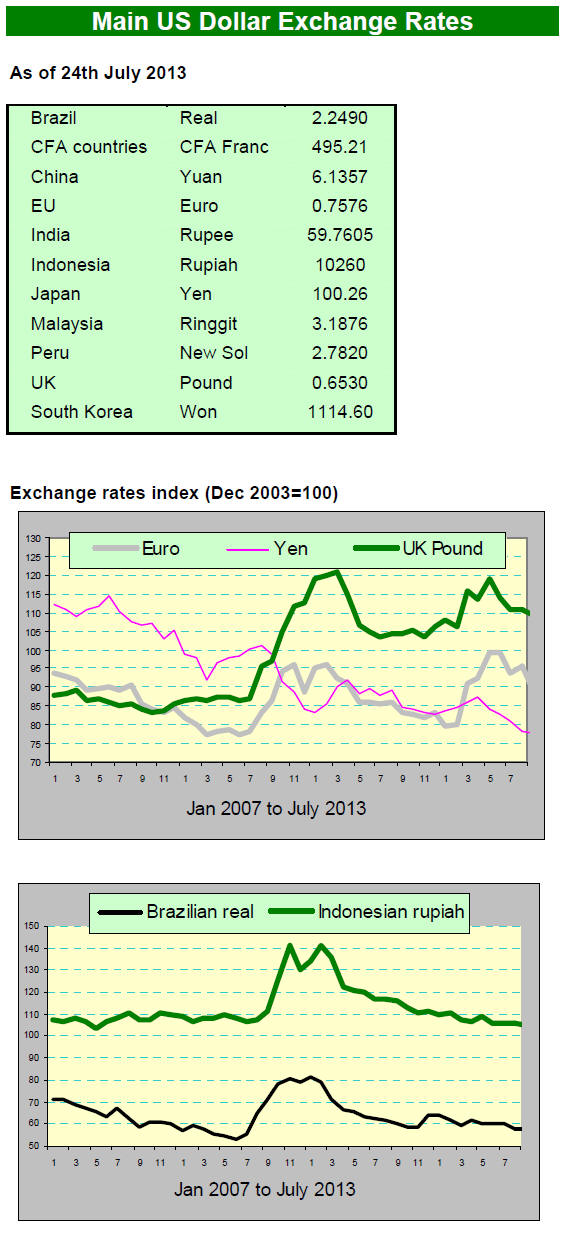However, the danger with programmes of this nature is that the
responsible, certified, legal and sustainable firms operating in tropical
areas to strict business standards also get tarred with the same brush.
It highlights the need for all consumers to be aware of the origin
of the products they are buying, and for active, engaging due diligence to
be conducted, never accepting any products simply on good faith. This is
exactly what the EU timber regulation (EUTR) is intended to achieve.
2. GHANA
Upgrading the Abidjan-Lagos corridor road
On the 15th July the inaugural meeting of the five-nation ECOWAS Steering
Committee on the upgrading of the 1,030 km Abidjan-Lagos corridor road
project met to begin work on the legal and institutional framework, the
terms of reference for various studies and on finance and resource
mobilisation.
For the ECOWAS press release see:
http://news.ecowas.int/presseshow.php?nb=223&lang=en&annee=2013
The committee, comprised Ministers of Road Infrastructure, Transport, Public
Works, Finance and Justice of Benin, Cote d¡¯Ivoire, Ghana, Nigeria and Togo.
The road, which carries around 75 per cent of regional trade and impacts
some 30 million people, links major cities such as Lagos, Cotonou, Accra,
Lom¨¦ and Abidjan as well as the region¡¯s dynamic sea ports. The road also
serves landlocked countries such as Burkina Faso, Mali and Niger.
The committee recommended that a feasibility study be conducted prior to
securing financing support from the African Development Bank, the World Bank
and the African Finance Corporation.
The ministers further recommended that the BRIC countries (Brazil, India,
China and South Africa) should be approached with a view to securing the
required financing.
Independent power producers to solve power shortages
Ghana¡¯s ministry of energy has released details of an agreement with General
Electric (GE) for the building of additional power generation capacity in
the country to alleviate the problem of power outages.
In a press release the ministry says,¡°GE will be facilitating the
development, financing and technical partnership required for the
implementation of an incremental 1000MW of power in collaboration with the
Government of Ghana over the next 5 years.
(see:
http://www.energymin.gov.gh/?p=1539)
The agreement comes on the heels of the Government¡¯s proposed target to
generate a total of 5000 Megawatts by 2016.
The Minister for Energy and Petroleum, Honorable Emmanuel Armah-Kofi Buah,
commended GE on its efforts and stated that the Government of Ghana is
committed to achieving increased power outputs through strategic
collaboration with private sector investors.
He noted that the government is putting in place the necessary structures
and creating the enabling environment to attract the needed Independent
Power Producers (IPPs) to ensure that the country had a constant supply of
power for economic growth.
The ¡°Ghana 1000MW Project¡± will introduce the Power Park Concept to enable
lower cost of power and faster implementation.
GE plans to develop the Power Park in collaboration with partners and
investors as well as develop local capabilities and service providers in
plant operation and maintenance¡±.
Bamboo bio-energy technologies from INBAR
According to a Ghana News Agency report the International Network for Bamboo
and Rattan (INBAR), is promoting bamboo charcoal technologies in Ghana which
have the potential to contribute to growth in the bio-energy sector.
In a statement issued in Accra, the Country Director of INBAR, Michael Kwaku,
said the China-Africa collaboration focuses mainly on bamboo to provide
clean, safe and ¡®green¡¯ energy.
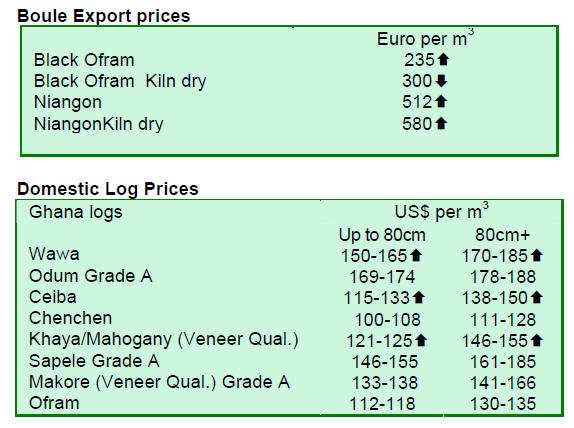
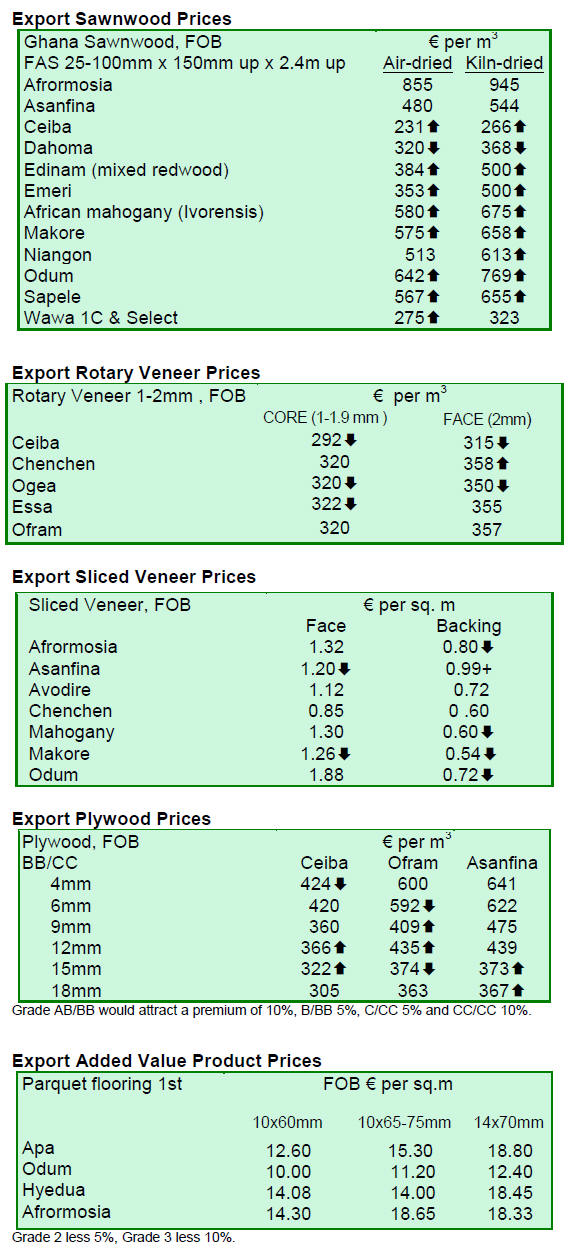
3. MALAYSIA
ITTO initiates work on EPD for tropical
timber
Experts from Indonesia and Malaysia met in Bogor, Indonesia to prepare the
workplan for development of environmental product declarations (EPDs) for
three tropical wood products, meranti plywood, ipe decking and khaya lumber.
In 2003, ITTO published a review of available information on Life Cycle
Analysis (LCA) for tropical timber products but did no further work until
initiating the current EPD project.
The ITTO Trade Advisory Group (TAG) has, over the last few years, vigorously
encouraged work on EPDs as international markets are demanding this
information on tropical timber products especially as EPDs are already
available for wood products from temperate and boreal countries and for
alternatives to wood.
The current work will fill a critical gap in the environmental data for
three tropical wood products and will hopefully stimulate more work tropical
wood products.
The expected outcomes from the current work include a Life Cycle database,
LCA reports for the three products conducted in line with ISO standards,
assessment of the carbon footprint for the three products in line with the
PAS2050 methodology and an overall EPD for each product examined.
What is PAS 2050?
PAS 2050 is a publicly available specification for assessing product life
cycle GHG emissions, prepared by BSI British Standards and co-sponsored by
the Carbon Trust and the Department for Environment, Food and Rural Affairs
(Defra).
PAS 2050 is an independent standard, developed with significant input from
international stakeholders and experts across academia, business, government
and non-governmental organisations (NGOs) through two formal consultations
and multiple technical working groups.
The assessment method has been tested with companies across a diverse set of
product types, covering a wide range of sectors.
Across-the-board increases in 2012 exports from Sarawak
The Sarawak Timber Industry Development Corporation (STIDC) reported that
the timber sector in Sarawak increased its contribution to state exports
from RM 7.1 billion in 2011, to RM 7.5 billion in 2012.
Plywood was the main export revenue earner. The volume of plywood exported
increased by 17% to 2.6 million cubic metres and the value of exports
increased 6% to RM 4 billion (approx. US$ 1.23 billion).
STIDC reported that Japan is still the biggest market for plywood from
Sarawak accounting for of 1.4 million cubic metres (RM2.3 billion) followed
by the Middle East 334,000 cubic meters (RM411 million) and Korea 331,000
cubic metres (RM427 million).
Exports to Japan, the Middle East and Korea constituted 79% of the total
volume of all sawnwood exports in 2012.
The STIDC reported that, although the volume of log
exports increased by 7% 3.3 million cubic metres compared to the 3.1 million
in 2011, the value of log exports fell 2% to RM1.8 billion.
The Sarawak Timber Association reported a total harvest of 3.48 million
cubic cubic metres of meranti logs last year which made up almost a third of
the 9.13 cubic metres of logs harvested last year.
India was the top buyer of logs with purchases of 2.1 million cubic metres
(RM1.2 billion), followed by Taiwan P.o.C 387,000 cubic metres (RM213
million) and China 345,000 cubic metres (RM176 million).
2012 exports of sawnwood increased by 12% to 822,000 cubic metres from
731,000 cubic metres in 2011. The corresponding increase in export earnings
grew by 13% to RM785 million.
Thailand remained the number one market for Sarawak sawnwood accounting for
240,000 cubic metres (RM235 million).
Indicative plywood prices for various markets
The Sarawak plywood manufacturers reported the following plywood FOB prices
for MR BB/CC quality boards; Taiwan P.o.C, 8.5-17.5mm, US$440; South Korea,
8.5-17.5mm, US$460; China/Hong Kong 9-18mm, US$450 and Middle East, 9-18mm,
US$430 ¨C 435.
Advancing Sustainable Trade in Asia
Because Asia can play an important role in unlocking the production and
trade of sustainable forest products PEFC will, in cooperation with the
Malaysian Timber Certification Council, hold its first Forest Certification
Week from 11-15 November 2013.
For more information see:
http://www.pefc.org/news-a-media/general-sfm-news/1231-pefc-forest-certification-week-2013-advancing-sustainable-trade-in-asia
¡°There are tremendous opportunities for stakeholders in Asia to contribute
to sustainable forest management in Asia, for both forest managers as well
as companies along the timber value chain,¡± said Ben Gunneberg, PEFC
Secretary General.
¡°As forest certification has yet to fully penetrate the Asian market and new
approaches are required to strengthen market demand, build capacity and
connect supply chains to deliver sustainable products.
PEFC will bring together diverse stakeholders across the forest sector
landscape for this year¡¯s Stakeholder Dialogue during the PEFC Forest
Certification Week, to take stock and identify opportunities to catalyze
action on and uptake of sustainable practices with respect to the forest
based sector within the Asian region¡±.
4. INDONESIA
Despite government subsidies SVLK
certification slow in Bali
The Bali Industry and Trade Agency reported that of the more than 250
exporters specialising in wooden handicrafts in Bali only 18 have been SVLK
certified.
Head of the forest product development division at Bali¡¯s Forestry Agency, I
Ketut Subawa has said that the Agency is finding it difficult to get
community forest owners and wood craft exporters to submit to SVLK
certification despite the subsidies provided by the Ministry of Forestry.
Forest owners and exporters are still not convinced of the benefits of SVLK
certification.
Community forests in Bali are small at just over 9,700 ha but currently only
around 60 ha. in Singaraja, Buleleng regency have been SVLK certified.
The Jakarta Post has reported Subawa as saying ¡°Honestly, we are unable to
provide the calculations when people ask what kind of price increase they
can obtain after having their timber certified.
However, we can only guarantee that having their timber certified prevents
them from having their products rejected in the export market.,¡±
In related news the Indonesian government has demanded an explanation from
EU officials on the delay in ratification of the VPA and a specific time
frame for completion of all the formalities in Europe.
SVLK clinics provide free support to industry
To support the timber industries secure the mandatory SVLK certification
consultation clinics have been established in Yogyakarta, Jepara, Surakarta,
Pasuruan, and Jombang.
The establishment of these clinics was initiated by a non-governmental
organization, Java Learning Center (Javlec), in collaboration with the
provincial trade and industry offices in the various cities. This effort by
Javlac is being supported by the Multi-Stakeholder Forestry Programme (MFP)-KEHATI.
The clinics provide advice to various stakeholders such as local government
officials, timber enterprises, associations and field facilitators. The aim
of this initiative is to address forest governance, licensing and
synchronisation of activities of the associations.
Domestic consumption will be future driver of economic growth
Indonesia¡¯s domestic demand continues to be robust, offsetting the slow
growth in exports.
According to research by McKinsey Indonesia, 90 million Indonesians will by
2030 be considered the ¡°consumer class¡±, a group with annual incomes
surpassing $3,600. This, says the McKinsey report, opens up business
opportunities which could be as high as US$1.8 trillion.
In a press release the Bank of Indonesia (BoI) has said that it expected the
economy to expand by 6.1 percent in 2013 and by around 6.4 to 6.8 in 2014.
On the other hand, the World Bank is now forecasting the Indonesian economy
to grow 5.9 percent in 2013, down from its previous forecast of 6.2 percent
in March.
However, the Bank report notes that expectations are for a moderate slowdown
in 2013 but the risk of a more pronounced slowdown is high as recovery in
exports is expected to be slow and domestic investment is likely to weaken.
In related news the BoI released CPI inflation data. See:
See:http://www.bi.go.id/web/en/Ruang+Media/Siaran+Pers/sp_151113_dkom.htm
Inflation in June 2013 increased 1.03% compared to one month earlier,
equivalent to 5.90% year on year which is consistent with the BoI
projections.
The escalation of inflationary pressures was anticipated because of the
recent lowering of fuel subsidies. The BoI expects the impact of higher fuel
prices to be temporary lasting approximately three months followed by a
subsequent easing.
The BoI press release also notes that increased exports reduced the trade
deficit in May. According to a Press Release issued today by BPS-Statistics
Indonesia, the trade deficit in May was amounted to US$ 0.6 billion, which
is smaller than that posted in April at US$ 1.7 billion. This was made
possible by an increase in exports.
Encouragingly, the pace of export growth is most pronounced for manufactured
goods, followed by primary goods.
Rupiah weakens sharply
On July 23 the rupiah was traded in the range of Rp10,120 ¨C Rp10,265 to the
dollar, a sharp drop from a month ago.The US dollar has strengthened
recently.
Adding to the downward pressure on the rupiah has been large foreign
exchange transactions by companies as well exchange transactions for
repatriation of dividend and investment returns.
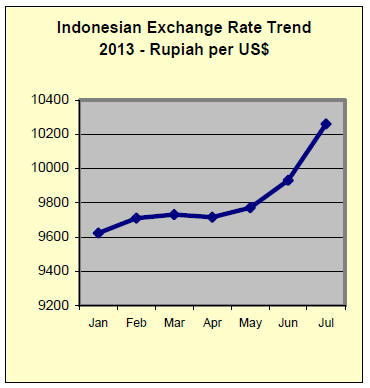
¡¡
For the BoI press release see:
http://www.bi.go.id/web/en/Ruang+Media/Siaran+Pers/SP_151713_DKom.htm
Compared to the exchange rate at the beginning of 2013 the rupiah has
depreciated almost 6%. Bank Indonesia Governor, Agus D.W. Martowardojo has
said, ¡°In the last few days, the rupiah has been converging to a new
equilibrium level which reflects the Indonesian economic fundamentals¡±.
He urged everyone to remain calm saying the BoI will continue to conduct
thorough surveillance and protect the stability of the currency in relation
to economic fundamentals.
Indonesia to host market dialogue in August
The Indonesian Exporters Association (GPEI), in collaboration with PT Mutu
Hijau Indonesia, will host the third High Level Market Dialogue - 2013 on
¡°The New Era of Indonesian Legal Timber Products to meet Global Markets¡±.
For information contact: Robianto Koestomo at
robiantokoestomo@mutuhijau.com
Up for discussion will be the Indonesian SVLK (Timber Legality Assurance
System), the Australian Illegal Logging Prohibition Bill, the EUTR (European
Union Timber Regulation) and developments in other markets for verified
legal timber products from Indonesia as well as how consumers are taking
action to eliminate illegal timber from their markets.
With the introduction of Australia¡¯s Illegal Logging Prohibition Act and the
coming into effect of the EU Timber Regulation, along with further
developments in the United States related to the U.S Lacey Act, as well as
developments in China and Japan, GPEI together with PT. Mutu Hijau Indonesia
see the value in once again convening a market dialogue, bringing together
Indonesian and international trading partners from the forestry and timber
sector.
The High Level Market Dialogue will be addressed by HE the Minister of
Forestry, HE the Minister of Trade, HE the Minister of Industry and Minister
of Cooperatives and Small and Medium Enterprises along with representation
from Australia¡¯s Department for Agriculture, Fisheries and Forestry, the UK
Permanent Under Secretary of State for International Development and the EC
Trade Commissioner.


¡¡
5. MYANMAR
Teak tender prices
The following prices were recorded for teak log sales during competitive
bidding on 26th and 29th July during the Myanma Timber Enterprise tender.
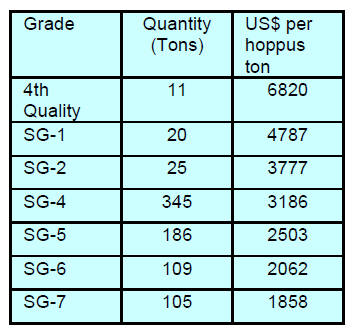

Vessels waiting for cargo as log deliveries are
slow
Natural teak is still reported to be trading below expectations and demand
for non-teak hardwoods remains very weak. Analysts say that delivery of logs
to the port has been slow such that vessels have to wait for cargoes.
Durable species like pyinkadoe and thitya, ingyin are currently poor in
demand. Some analysts say the weak Indian rupee has had a negative effect on
sales as India is the major buyer of Myanmar teak.
Myanmar timber certification committee replaced
The Ministry of Environmental Conservation and Forestry (MOECAF) has
established a Myanmar forest certification committee (MFCC) which replaces
the old Myanmar timber certification committee.
The new committee is more broad-based as it includes members from various
ministries such as Health, Labour; National Planning, Science and
Technology; Attorney General¡¯s Office; Myanmar NGO¡¯s and the Myanmar Timber
Merchants¡¯ Association.
Some say this new committee lends more credibility to the process as it
includes representatives outside of MOECAF.
Raising awareness on the EU FLEGT Action Plan
An EU-MOEFCAF workshop on FLEGT was held at the capital city, Naypyitaw in
mid July and the MOECAF Minister, Win Tun, provided an opening address.
The workshop was attended by the Director-Generals of MOECAF and officials
from the EU. One of the aims of the workshop was to increase awareness of
the EU FLEGT Action Plan and the changes in the international timber
markets.
Myanmar has not yet entered into negotiations with the EU on a VPA. Analysts
say that it is definitely in the interest of the country to adopt a credible
domestic system of legality verification.
Analysts expect Myanmar may follow the steps taken by other ASEAN member
countries.
The consensus is that until an internationally acceptable scheme for
legality verification is implemented in the country exporters may find it
very difficult to expand trade with EU member states.
¡¡
6.
INDIA
Exports fall but revival expected in
second quarter
Exports declined in the first quarter of fiscal 2013 dropping by almost 1.5%
year on year to US$72.4 billion.
At the same time imports of gold and silver also were down which helped
narrow the trade deficit to a three month low of US$12.2 billion in June
2013, a healthy figure when compared to the high of $20.1 billion in May.
Declining exports are a global phenomena for those countries pursuing export
led growth. China, for example, recorded a contraction in exports in June.
Indian exporters are asking the government to arrange an export credit
facility as they are now severely hit by high interest rates from commercial
banks.
The Indian Industrial Production Index also fell in May which, say analysts
surprised many. Weak output numbers were anticipated but no-one expected
negative growth.
However, despite the gloomy first half data
analysts are optimistic that the export performance will have picked up in
the second quarter. All eyes will be on the second quarter trade numbers
when they are released.
Industry fears re-introduction of import duties on wood products
India¡¯s trade deficit in the April-June period was a hefty US$50 billion
compared with US$42.2 billion in the corresponding period last year. The
numbers show that while exports fell imports rose. It has been reported that
the government is considering raising import duties on high cost items and
on gold.
Unfortunately wood and wood products are also included in the list of items
for which import duties may be raised. The timber industry has been quick to
point out that wood products are a basic raw material required for house
building and for domestic manufacturing industries.
Import duties on wood products were removed some time ago when the current
prime minister was finance minister. The removal of import duties was
applauded by the forestry sector for the positive impact it had on reducing
illegal logging and over cutting of domestic forests.
The industry and forestry sector feel that the re-imposition of import
duties on wood products would be unfortunate as the benefits of duty free
wood product imports for the economy and forest security would be lost.
Domestic teak prices climb at local auctions
The effects of higher landed costs of imported logs and wood products are
now being felt in the domestic trade and on sale prices for domestic timber.
Recent auctions prices paid by millers have increased and average prices per
cubic foot ex-depot were as follows:
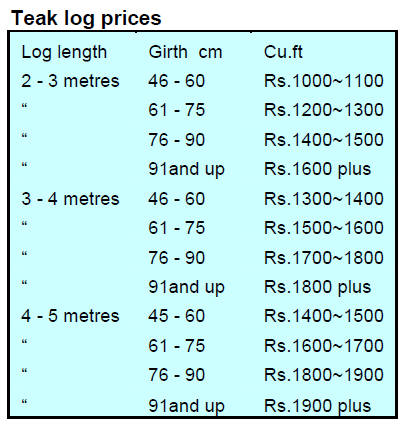
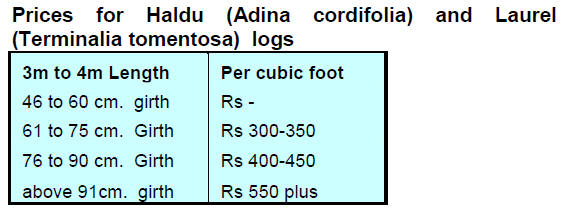
Imported plantation teak prices
The demand for teak in India seems insatiable but the continued depreciation
of the rupee is pushing up the cost of teak imports. Current prices, C & F
Indian ports per cubic metre are shown below.
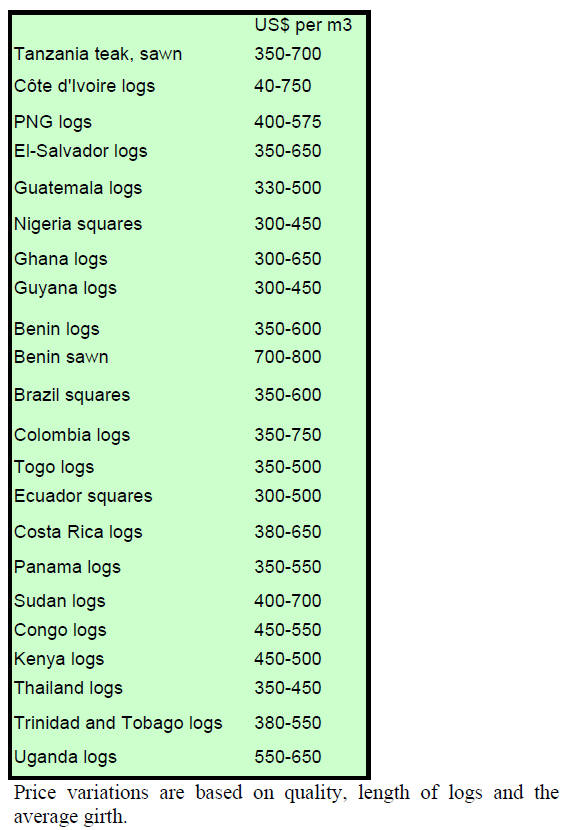
¡¡
Ex-mill prices for sawnwood
Domestic ex-sawmill prices for air dried sawnwood cut from imported logs.
Price per cubic foot is shown below.
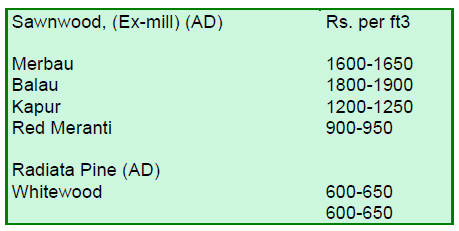
Domestic prices for Myanmar teak processed in
India
Slowing demand has resulted in relatively stable price structures.

Price variations depend mainly on length and cross
section.
Prices for imported sawnwood
Ex-wharehouse prices for imported kiln dry (12% mc.) sawnwood per cu.ft are
shown below.
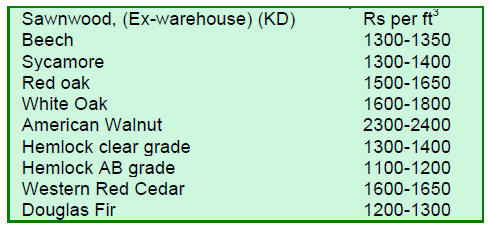
Price variations depend mainly on length and cross
section.
Plywood prices advance once more
Strong demand and the rising costs of resins and logs due to exchange rate
fluctuations have resulted in plywood manufacturers raising prices once
more.

Imperial tobacco reports on plantation
initiatives
Social and Farm Forestry initiatives by Imperial Tobacco Company (ITC) have
added more than 17,000 hectares of plantations during 2012-13 and this
brought the cumulative area of plantations to around 142,000 hectares.
Planting activities have increased the ¡®green cover¡¯ improved raw-material
supplies and have generated over 64 million man-days of employment for rural
households including poor farmers.
The combined planting of trees and agricultural
crops during the early years of the plantation provides for agricultural
increased agricultural production.
7.
BRAZIL
Unfavourable outlook for inflation
Brazil¡¯s balance of payments posted a deficit of US$1.3 billion in June and
the current account turned in a deficit of US$4 billion, accumulating a
deficit of US$72.5 billion in the 12-month period up to June, equivalent to
3.17% of GDP.
Brazil¡¯s Consumer Price Index (IPCA) eased 0.26% in June falling below the
0.37% registered in May 2013 resulting in the lowest IPCA since June 2012.
In June the average exchange rate was BRL 2.17 to the U$ dollar compared to
BRL 2.05 a year ago.
For the third consecutive time the Central Bank adjusted the interest rates
as it moved to tame increasing inflation. The Monetary Policy Committee (Copom)
increased the Selic rate by 0.5 percentage point to 8.5% per year and
analysts say it could go to 9% in the next few months after starting 2013 at
just 7.25%, a historic low.
A note on the Central Bank website says ¡°The committee considers that this
decision will contribute to put inflation on the decline and assure that
this trend will persist next year.¡±
Greater than anticipated inflationary pressures have caused domestic prices
to rise sharply prompting street protests. The higher than forecast
inflation has undermined the effects of government stimulus measures and
affected consumer confidence, industrial output and retail sales. Policy
makers have reiterated warnings that the outlook for inflation remains
unfavorable.
Appreciation of US dollar pushes up domestic furniture prices
The Association of Furniture Industries of the State of Rio Grande do Sul (MOVERGS)
has said that the recent appreciation of the US dollar was one of the main
reasons for last months¡¯ increase in furniture prices.
The stronger dollar raises the cost of imported inputs and raw materials and
companies find hard to absorb the higher production costs so must pass the
rise onto consumers. High production costs are an obstacle to the furniture
industry of Rio Grande do Sul state.
Despite government incentives such as the home development programme ¡°My
Better Home¡± (Minha Casa Melhor) which offers access to competitive credit
for low-income families for the purchase of furniture and appliances
furniture, manufacturers have not been able to recover their competitiveness
in either the domestic or international market.
The extension, until only September this year, of
the reduction in the tax on industrialized products (IPI) for furniture also
influenced furniture prices say furniture producers.
While the extension of the tax reduction could boost sales in the
short-term, manufacturers are looking long term and preparing for the
tougher trading conditions to come.
New furniture centre and industrial park in Acre
Manufacturers in the municipality of Xapur¨ª, state of Acre, are benefiting
from a new furniture cluster and restructuring of the old Industrial Park.
This investment by the state government is aimed at stimulating the timber
sector economy and at bringing workers in the sector into the formal,
registered workforce.
Until now workers in the sector operated informally and could not secure
state production and environmental licenses. This made it difficult for them
to purchase raw materials in the regular market forcing them to turn to
alternative, often illegal, suppliers.
The creation of furniture clusters was made possible through support from
the Brazilian Development Bank (BNDES) which allocated some BRL 17 million
for this and other activities. The plan is to construct and refurbish 10
industrial parks for the sector.
The Acre state government recognises the value of the wood product
manufacturing sector and wants to provide stable and decent working
conditions for workers in the sector so they can contribute to the economic
development of the State.
June export trends encouraging
In June 2013, wood products exports (except pulp and paper) increased 7.7%
compared to values in June 2012, from US$190.9 million to US$205.6 million.
Pine sawnwood exports increased 3.1% in value in June 2013 compared to June
2012, from US$12.9 million to US$13.3 million. In terms of volume, exports
fell 2.4%, from 59,500 cu.m to 58,100 cu.m over the same period.
Tropical sawnwood exports declined 5.4% in volume, from 31,600 cu.m in June
2012 to 29,900 cu.m in June 2013 (from US$15.6 million to US$15.5 million).
Pine plywood exports declined 3.2% in value in June 2013 compared to June
2012, from US$34.2 million to US$ 33.1 million (from 87,600 cu.m to 85,700
cu.m.).
In a reverse of recent trends, tropical plywood exports increased 4.9% in
volume, from 4,100 cu.m in June 2012 to 4,300 cu.m in June 2013. But the
value of exports fell 7.7%, from US$2.6 million in June 2012 to US$2.4
million in June 2013.
A slight decline in furniture exports was recorded in June 2013. Furniture
export values fell from US$38.2 million in June 2012 to US$ 37.9 million in
May 2013.
Potential in Colombian furniture market assessed
The ¡®Brazilian Furniture Project¡¯ supported by the Brazilian Agency for
Export Promotion and Investments (Apex-Brazil) will provide information to
furniture manufacturers on opportunities in the Colombian furniture market.
The ¡®Brazilian Furniture Project¡¯ currently brings together 64 companies
offering them benefits such as access to business intelligence, information
and participation in national and international events.
The main target markets are the United States, Mexico, Peru, Chile, the
United Arab Emirates, Colombia, South Africa, Russia and Angola.
Apex-Brazil says Brazil¡¯s furniture exports to Colombia can be increased.
Colombia imported furniture valued at US$ 185.3 million last year but Brazil
accounts for just 6% of this total. Imports from the United States accounted
for 8% while imports from China were a massive 50%.
Brazilian exporters hope to capitalise on their design, aesthetic style
furniture, functionality and quality to secure a larger slice of the
Colombian market.

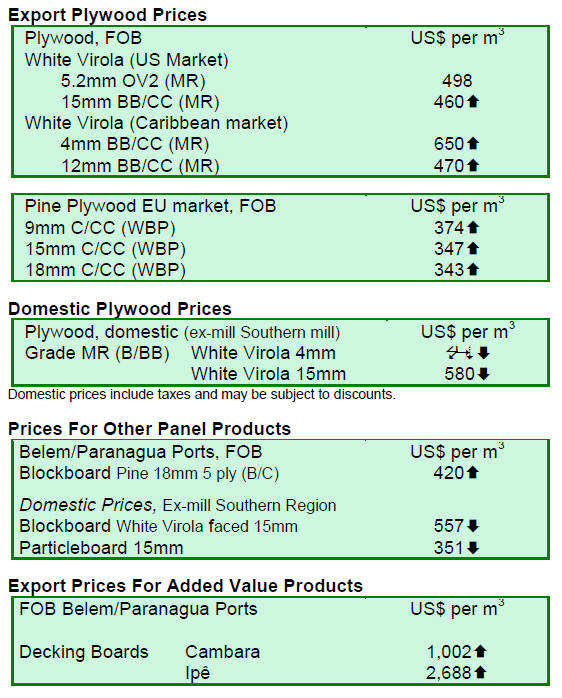
8. PERU
New ¡®Atlas¡¯ a tool to prevent misuse
of the natural forest
The much awaited forest concession Atlas which identifies forest cover loss
due to various practices has been launched by the National Forest
Supervisory and Wildlife Resources Service (OSINFOR). This Atlas provides a
tool to assess and therefore plan prevention of misuse of the natural
forest.
OSINFOR is the national body responsible for supervising and monitoring the
sustainable use and conservation of forest resources and wildlife.
The Atlas will eventually identify areas prone to erosion and loss of
biodiversity and will help identify forest loss from shifting cultivation,
the biggest risk to tropical forests in the country.
The Atlas contains recommendations on the design and implementation of a
geographic information system for the management and presentation of
information gathered. It also illustrates a conceptual model and the
application of the proposed Geographic Information System using GIS analysis
software ArcGIS 10.0.
Value the forests to encourage domestic growth says ADEX
Erick Fischer, chairman of Wood and Wood Industry Exporters Association (Adex)
said last week that exports of wood products for the first half of this year
fell almost 6% because of weak international and domestic demand.
He further indicated that the timber sector has the potential to contribute
more to the national economy as there is an area of around 17 million
hectares of permanent production forests that can be harvested sustainably.
"The current system of forest management and concession allocation fails to
(adequately) value the forests as a means to encourage domestic growth¡±, he
said.
In this regard, there is a need to promote policies in which the central
government empowers regional governments for implementation of effective
management to achieve sustainable timber flows to the domestic industry.
Programme for recovery and conservation of Amazonian forests
The Inter-American Development Bank has provided funds for a sustainable
forest development programme, some of which will be used for development
activities in the Peruvian Amazon."
According to the Ministry of Economy and Finance (MEF), this programme is
aimed at the recovery and conservation of Amazonian forests by strengthening
public forestry institutions and the competitiveness of the forest sector.
Its implementation will be the responsibility of the Ministry of
Agriculture, through the National Forest Service and Wildlife (SERFOR).
Peruvian plantation company executives learn from Chilean counterparts
A group of businessmen whose companies are involved in reforestation
recently visited Chile to get first hand experience of the latest
technological advances related to site preparation, mechanised planting,
tree breeding and modern nursery technology.
The group also examined industrial plantation harvesting and utilisation
systems for chip, pulp, paper and solid wood product manufacture.
The visit enabled the privates sector group from Peru to interact directly
with their Chilean counterparts. Analysts suggest this visit has motivated
the Peruvian group to move forward in their plantation development
investments.

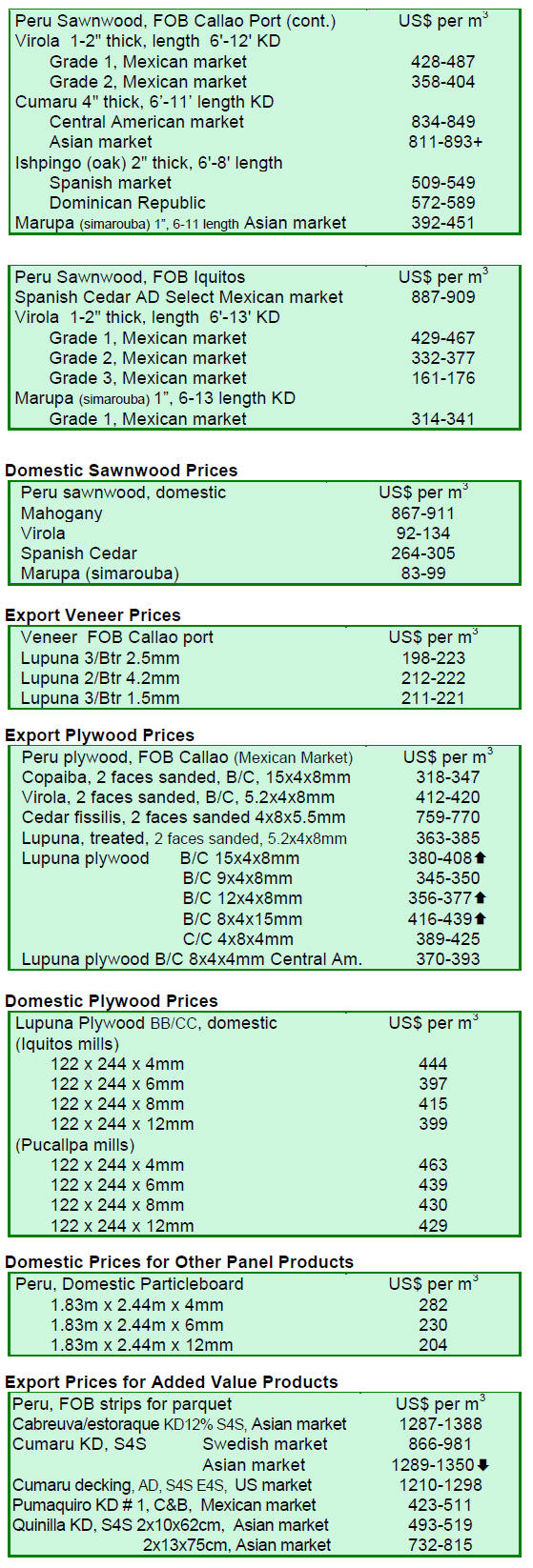
¡¡
9.
GUYANA
Firm demand in Asia for wide variety
of Guyana logs
Greenheart logs are yet to attract overseas buyers and during the period
reviewed there were no exports of greenheart logs.
On the other hand, exports of purpleheart logs continue and purpleheart
Standard Sawmill Quality logs attracted favourable top end prices of US$235
per cubic metre FOB, while purpleheart Fair Sawmill Quality logs were traded
at top end FOB prices of US$205 per cubic metre. There were no exports of
Mora logs during this period.
Asia continues to be the main market for Guyana¡¯s logs. In addition to
greenheart, purpleheart and mora several other species such as kabukalli (Goupia
glabra), shibadan (Aspidosperma album) and wamara (Swartzia leiocalycina)
were in demand in Asian markets.
Sawn white silverballi attracts buyers in Qatar
Sawnwood exports continue to make a valuable contribution to total export
earnings.
Undressed greenheart FOB prices eased in the period reviewed. Select Quality
greenheart undressed sawnwood top end FOB prices fell slightly from US$1,230
to US$954 per cubic metre.
Sound Quality greenheart undressed sawnwood earned as much as US$636 per
cubic metre FOB, while Merchantable Quality FOB prices held at US$636 per
cubic metre.
Undressed purpleheart was shipped to the US at a significantly higher top
end price of US$1,908 per cubic metre. Other markets for Undressed
purpleheart included the Caribbean, Qatar and New Zealand.
During the period reviewed Undressed mora Select Quality FOB prices advanced
from US$500 to US$594 per cubic metre.
In addition to the trade in species mentioned above there were sales of
Undressed Sawn white silverballi (Ocotea canaliculata) at a high end price
of US$2,218 per cubic metre FOB in the Middle Eastern market.
Trade in dressed sawnwood improves
Export prices for sawn Dressed greenheart were good and the top end price
increased from US$1,060 to US$1,166 per cubic metre FOB in the Caribbean
market.
In contrast Dressed purpleheart prices remained unchanged at US$1,102 per
cubic metre FOB.
Sawn Dressed kabukalli (Goupia glabra) earned favourable market price
earning as high as US$975 per cubic metre FOB.
Caribbean markets significant consumers
Guyana export plywood FOB prices dropped marginally from US$584 to US$578
per cubic metre. Splitwood (shingles) were traded at US$977 per cubic metre
FOB with the Caribbean being the leading market for this product.
Roundwood (greenheart piles) secured good prices of US$ 599 per cubic metre
FOB in the North American market while exports of wallaba posts fetched fair
prices of US$510 per cubic metre FOB in the Caribbean.
Update EU FLEGT VPA Process
The VPA process has been moving within the timeframe set out in the
¡®roadmap¡¯ agreed between Guyana and the European Union.
The National Technical Working Group (NTWG) held consecutive weekly meetings
in preparation for the second round of negotiation focusing on progress on
the development of the VPA Objectives and Structure, the Scope of Agreement,
the Legality Definition, Compliance Framework, Community Importation
Procedures and the FLEGT License Specification.
In addition, preparations were also being made to present the issues and
concerns arising from the process.
A second round of negotiations was held in Brussels on July 18 and the
National Technical Working Group was comprised of 14 members representing
all of the major stakeholder groups.
Guyana participates in Chatham House meeting
Guyana was given the opportunity to participate at a Chatham House meeting
on the VPA on July 8 and 9 in London.
Representatives from Guyana¡¯s private sector, government and civil society
attended the meeting and each group was given the opportunity to report on
progress made on the FLEGT VPA ¡®roadmap¡¯.
Presentation topics included: Guyana¡¯s engagement with EU FLEGT VPA ¨C
progress to date, good Guyanese timber ¨C A participatory approach, Building
the competence of indigenous communities in relation to Guyana-EU FLEGT VPA
and Forest activities in indigenous communities.
Consultants identified for VPA communication strategy development
The government of Guyana has completed the recruitment process for
consultants to design a communication strategy and the scoping of impacts
for the VPA. Work on both the communication strategy and the Scoping of
Impacts is scheduled to commence shortly as they are integrally a part of
the development of the VPA.

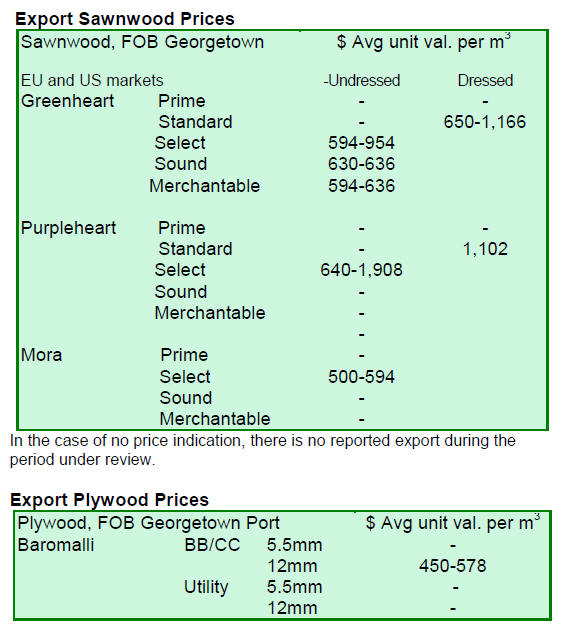
¡¡
